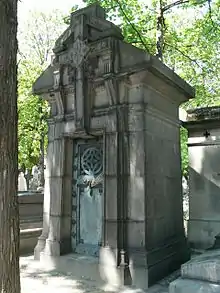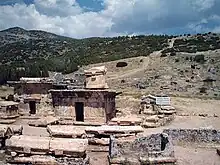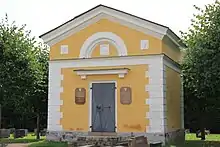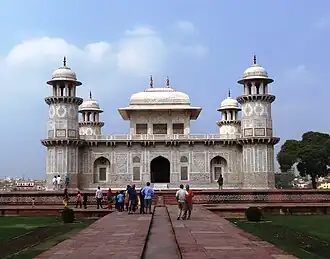Tomb
A tomb (Greek: τύμβος tumbos[1]) is a repository for the remains of the dead. It is generally any structurally enclosed interment space or burial chamber, of varying sizes. Placing a corpse into a tomb can be called immurement, although this word mainly means entombing people alive, and is a method of final disposition, as an alternative to cremation or burial.
Overview




The word is used in a broad sense to encompass a number of such types of places of interment or, occasionally, burial, including:
- Architectural shrines – in Christianity, an architectural shrine above a saint's first place of burial, as opposed to a similar shrine on which stands a reliquary or feretory into which the saint's remains have been transferred
- Burial vault – a stone or brick-lined underground space for multiple burials, originally vaulted, often privately owned for specific family groups; usually beneath a religious building such as a
- Church
- Cemetery
- Churchyard
- Catacombs
- Chamber tomb
- Charnel house
- Church monument – within a church (or a tomb-style chest in a churchyard) may be a place of interment, but this is unusual; it may more commonly stand over the grave or burial vault rather than containing the actual body and therefore is not a tomb.
- Coemeterium
- Crypts – often, though not always, for interment; similar to burial vaults but usually for more general public interment
- Funeral home
- Hypogeum tomb – stone-built underground structure for interment, such as the tombs of ancient Egypt
- Kokh (tomb) – a rectangular rock-cut sloping space, running inward, like tunnels into rock, sufficiently high and wide to permit the admission of a corpse
- Martyrium – Mausoleum for the remains of martyrs, such as San Pietro in Montorio
- Mausoleum (including ancient pyramid in some countries) – external free-standing structure, above ground, acting as both monument and place of interment, usually for individuals or a family group
- Mazar, Marqad or Maqbara (Islamic terminology for tombs of notable religious figures or saints, or mausolea):
- Megalithic tomb (including Chamber tomb) – prehistoric place of interment, often for large communities, constructed of large stones and originally covered with an earthen mound
- Necropolis
- Ohel, a structure built around the grave or graves of Hasidic Rebbes, prominent rabbis, Jewish community leaders, and biblical figures in Israel and the diaspora
- Pillar tomb – a monumental grave. Its central feature is a single, prominent pillar or column, often made of stone.
- Rock-cut tomb – a form widespread in the ancient world, in which the tomb is not built but carved out of the rock and can be a free-standing building but is more commonly a cave, which may be extensive and may or may not have an elaborate facade.
- Sarcophagus – a stone container for a body or coffin, often decorated and perhaps part of a monument; it may stand within a religious building or greater tomb or mausoleum.
- Sepulchre – a cavernous rock-cut space for interment, generally in the Jewish or Christian faiths (cf. Holy Sepulchre).[2]
- Samadhi – in India a tomb for a deceased saint that often has a larger building over it as a shrine
- Other forms of archaeological "tombs", such as ship burials
- Tumulus – (plural: tumuli) A mound of earth and stones raised over a grave or graves. Tumuli are also known as barrows, burial mounds, Hügelgräber or kurgans', and can be found throughout much of the world. A cairn (a mound of stones built for various purposes), might also be originally a tumulus. A long barrow is a long tumulus, usually for numbers of burials.
As indicated, tombs are generally located in or under religious buildings, such as churches, or in cemeteries or churchyards. However, they may also be found in catacombs, on private land or, in the case of early or pre-historic tombs, in what is today open landscape.
The Daisen Kofun, the tomb of Emperor Nintoku (the 16th Emperor of Japan), is the largest in the world by area.[3] However, the Pyramid of Khufu in Egypt is the largest by volume.
Composition
Notable examples:
- Dartmoor kistvaens
- Mausoleum at Halicarnassus
- Great Pyramids
- Taj Mahal
- Tomb of Alexander the Great
- Tomb of Genghis Khan
- Mausoleum of the First Qin Emperor
- Green Dome, which contains the tombs of Muhammad and two of his elite companions, housed within the Prophet's Mosque in Medina
- Catacombs of Paris
- Catacombs of Rome
- The Panthéon
- Church of the Holy Sepulchre, which contains the empty tomb of Jesus, where according to early Christian tradition he was buried and resurrected.
- Thracian Tomb of Kazanlak, Bulgaria
- Thracian Tomb of Sveshtari, Bulgaria
- Tomb of Seuthes III, Bulgaria
- Tomb of the Unknown Soldier
See also
References
- τύμβος, Henry George Liddell, Robert Scott, A Greek-English Lexicon, on Perseus Digital Library
- Morana, Martin (2011). Bejn Kliem u Storja (in Maltese). Malta: Books Distributors Limited. p. 211. ISBN 978-99957-0137-6. Archived from the original on 20 October 2016.
- Merueñas, Mark (4 November 2012). "Where emperors sleep: Japan's keyhole-shaped burial mounds". GMA News Online. Retrieved 11 January 2017.
The Nintoku-ryo tumulus is one of almost 50 tumuli collectively known as "Mozu Kofungun" clustered around the city, and covers the largest area of any tomb in the world.
External links
 Media related to Tombs at Wikimedia Commons
Media related to Tombs at Wikimedia Commons


